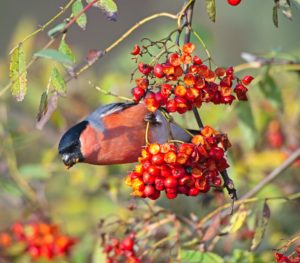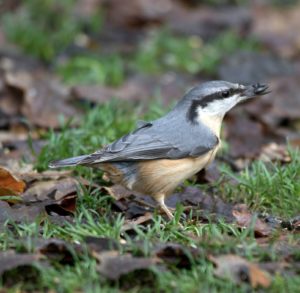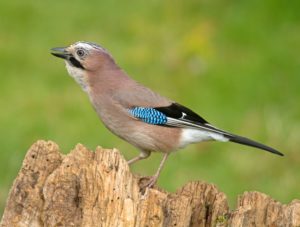I have spent all my youth and adult life in the Welwyn area and as a young man frequently walked up Whitehill or School Lane to Ayot St Peter church and sometimes beyond to Ayot Green. I joined the British Trust for Ornithology (BTO) who carry out bird population surveys using volunteers and have always been involved in sending records of observations to them for various surveys and for their Nest Record Scheme.
Bird watching and the Breeding Bird Survey

When in 1994 the BTO started a new survey of breeding birds I was an instant volunteer. I was given a randomly selected 1km square through which I had to plan a walk in two directions. The survey area included Whitehill, The Frythe, Ayot Green and part of Sherrardspark Wood. I planned my walk and have done the same walk every year, on two designated dates at the beginning of May and the end of May or first week of June. Normally my BBS dates include either the Saturday or Monday mornings of the Bank Holiday weekends. I have only missed one year (1998) due to a broken leg from a car accident. I normally need to get up early to be at the start of my walk by about 7am and complete it by 9am.
The Breeding Bird Survey (BBS) uses thousands of volunteers like me all over the UK and so year by year, they have calculated an index of abundance for each species all over the UK that can compared between years and now over two decades. The data collected is used to compare local, regional and national changes and is collated with other surveys for individual species. There is always a sense of satisfaction for completing my survey walks and filling in the online data forms and knowing my data is contributing to something worthwhile as well as the individual pleasure of hearing and seeing the birds I record. In addition to the BBS walks in Ayot I have also been involved in individual surveys for skylark, farmland buntings and winter thrushes.
Local observations and changes

On average, I record about 25 to 30 species each year, although the total list across all years is 55. This shows that some species are only recorded on an occasional basis. The less commonly recorded species in the area have included buzzard and sparrowhawk, tawny owl (one once seen roosting in tree), swift and swallow, whitethroat and lesser whitethroat, spotted flycatcher, tree pipit, linnet and yellowhammer.
The most abundant species is the woodpigeon, that also happens to be the most widespread and recorded species throughout the UK. Across the years, in no particular pattern, I have counted between 17 to 44 on each visit, usually about 25 to 30 is typical. Woodpigeon has become a very successful species adapting to wooded areas, farmland and increasingly woody gardens. Some may say it is say too successful and a pest.

I have found that blue tit and great tit numbers have varied greatly between years although not in any specific pattern. Some years I have recorded as many as 28 blue tits on a walk, other times as low as just 4, as I found this year. Somewhere between 8 to 15 is more typical across most years. There does not seem to be any long-term decline and national figures show healthy populations for both blue tits and great tits.
The three thrush species (blackbird, song thrush and mistle thrush) appear to have some relatively stable populations in the area, with blackbird the most common (15 to 25 most years on record). Robins are also always recorded (9 to 25 most years) as are wrens (6 to 25 most years).
Another variable species is jackdaw. Counts tend to be variable because the species is sometimes encountered in flocks near breeding colonies and there is one small colony I have noted around the houses on Ayot Green. (Maybe you have pairs trying to nest in your chimneys).
Chiffchaff and blackcap are two common summer visiting warblers and I normally find a few of each every year. Again, there does not appear to be any particular pattern across the years although both species have shown increased abundance across the whole of the UK.

Raptor species such as kestrel, sparrowhawk, buzzard and red kite tend to have large territories so the chances of seeing any of them on either of the two walks are quite low. They are not always apparent and so in most years I have no records for BBS even if I have seen them on other walks Even so, it has become evident from other surveys and walks that buzzard and red kite have become more commonly sighted in the area, as they are now in many other parts of Hertfordshire. It is always a pleasure to record them on the visits when they do occur. On one occasion as I was walking through Ayot Green some-one pointed out to me a tawny owl roosting in a tree. I noted it down but confess I would not have known it was there had it not been pointed out at the time.
As there are some ponds on the farmland and in few gardens, I have occasionally seen mallard and moorhen.
I walk pass a few fields on my walk and here meet with something that for me has become a sad fact of life. Even before the BBS started in 1994 there had been evidence from other national surveys that species typically present in arable environments (such as skylark and yellowhammer) had suffered catastrophic national and widespread declines of more than 50% since the 1970s. Evidence from various surveys was that intensification of sowing, switching to autumn sown cereals and use of pesticides was lowering the ecological quality of the landscape and was resulting in loss of insects, loss of over–winter food sources and fewer nesting opportunities. While I can remember skylarks singing in Ayot fields, and yellowhammers in the hedgerows in my youth, during the last ten years I have not observed skylarks or yellowhammers during my BBS visits, and no more than one or two on other additional visits. Since 2008 I have also not heard or seen a cuckoo.

Another species in trouble is the house sparrow. I had regular records in the Ayot Green area of 2 to 4 in the early years of the BBS survey but none recorded since 2005. This goes along with the pattern in other rural, suburban and urban surveys. There may be isolated populations of house sparrow but if they decline, the nature of their fidelity to breeding areas means that they do not easily become naturally resettled. If you do happen to have house sparrows in your garden treasure them and help with regular food provision, including during summer. It also important to provide fresh drinking water for all birds, especially in hot, dry weather.

Ayot is a beautiful area to walk and enjoy the countryside and I hope that people take an interest in what is around them, particularly the birds, and think about their welfare.

Colin Hull 2018
Colin is happy to receive observations and comments. Please use the contact tab on this website.
For more information about the British Trust for Ornithology and the Breeding Bird Survey (“BBS”) please see their website – British Trust for Ornithology
I am indebted to John Harding and the BTO for the use of the photographs, which are copyright to them.